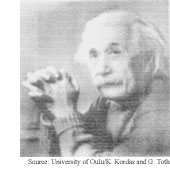|
NEWS
|
Inkjetting nanotubes
 An ordinary inkjet printer filled with ink made
from modified carbon nanotubes puts electrically conductive
patterns on paper and plastic. The method could be used
to make inexpensive gas sensors, fuel-cell electrodes,
flexible displays and radio frequency identification tags.
(Inkjet
Printing of Electrically Conductive Patterns of Carbon
Nanotubes, Small, August 2006)
An ordinary inkjet printer filled with ink made
from modified carbon nanotubes puts electrically conductive
patterns on paper and plastic. The method could be used
to make inexpensive gas sensors, fuel-cell electrodes,
flexible displays and radio frequency identification tags.
(Inkjet
Printing of Electrically Conductive Patterns of Carbon
Nanotubes, Small, August 2006)
Chip laser shines nano spots
Optical storage devices and magnetic disc drives
that use lasers as heat sources could pack more information
per square inch thanks to a modified laser diode that
produces 40- by 100-nanometer spots of bright near-infrared
light. The laser diode has a pair of closely-spaced nanoscale
gold rectangles attached to its face, and light shone
through the gap onto a nearby surface produces the unusually
small spots. (Plasmonic
Laser Antenna, Applied Physics Letters, August 28,
2006)
3D nanowire paper
Long titanium dioxide nanofibers form a type of
paper that can be used in chemical and bacterial filters,
flame-retardant fabrics, drug delivery devices and chemical
catalysts. The nanowire paper can be shaped into sheets,
tubes, bowls and other three-dimensional objects. (Multifunctional,
Catalytic Nanowire Membranes and the Membrane-Based 3D
Devices, Journal of Physical Chemistry B, August 31,
2006)
Molecular barcodes
A form of molecular computation -- using chemicals
as inputs and outputs and chemical reactions as simple
logic operations -- produces millions of unique, easily
read fluorescent colors. The colors can be used to make
chemical barcodes for tracking many individual cells at
once for medical diagnostics and biological studies. The
chemical barcodes would also make it possible to track
tiny beads used in combinatorial chemistry. (Molecular
Computational Elements Encode Large Populations of Small
Objects, Nature Materials, October 2006)
Microscopes set to go hyper
A theoretical study shows that the right kind
of superlens converts near-field light to ordinary propagating
light. Near-field light can be used to see nanoscale objects,
but it can't be magnified and channeled using lenses and
mirrors, which means it can only see a tiny portion of
a sample at a time. Superlenses are lenses made of materials
that bend light waves the wrong way. The hyperlens design
could be used to make optical microscopes that are more
powerful than today’s. (Optical
Hyperlens: Far-Field Imaging Beyond the Diffraction Limit,
Optics Express, September 4, 2006)
Entangled quantum crypto demo
An experimental quantum cryptography system uses
entangled photon pairs to provide secure communications
between sites 1.5 kilometers apart. Entangled photon pairs
are difficult to generate but make quantum cryptography
systems less vulnerable to eavesdropping than quantum
cryptography systems that use the quantum properties of
single photons. (Free-Space
Quantum Key Distribution with Entangled Photons, Applied
Physics Letters, September 4, 2006) |
FEATURES
|
View
from the High Ground: ICL's John Pendry
Physics as machine tool, negative refractive
index, metamaterials, shattered wine glasses, higher capacity
DVDs, scientific backwaters, risk perception and practice,
practice, practice.
|
How
It Works: Quantum computing: qubits
Photons, electrons and atoms, oh my! These particles are
the raw materials for qubits, the basic building blocks
of quantum computers. |
|
 |
News RSS feed 
Blog RSS feed 
Bookshelf RSS feed

New: TRN's
Internet Services
TRN's Jobs Center
|
| |
|
| |
|
| |
"Physics
is to the rest of science what machine tools are
to engineering. A corollary is that science places
power in our hands which can be used for good or
ill. Technology has been abused in this way throughout
the ages from gunpowder to atomic bombs."
- John Pendry, Imperial College London |
|
| |
|
| |
Thanks
to Kevin from
GoldBamboo.com
for technical support |
|

